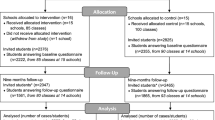Abstract
This study examined the effectiveness of two cancer prevention interventions in improving balanced diet among French children aged 12–14 years. The educational techniques used were taken from the taxonomy of behaviour change techniques (BCTs; Abraham & Michie, 2008). Allocation to intervention group (intervention versus control) was randomised at the school-level, the intervention group received two interventions, each of 1-h duration, containing BCTs including advocated attitude, anticipated success/regret, behaviour modelling and barrier identification. Self-reported diet was assessed pre- and post-interventions. The resulting data were coded by a nutritionist and transformed into a novel measure representing the extent to which the participant achieved a balanced diet. Multilevel modelling indicated that, having taken into account the clustered nature of the data, gender and the differing socio-economic status of the participants, balanced diet decreased over time, b = −1.23, t(1830) = −2.79, p = 0.005, but this was qualified by a significant interaction effect with intervention, b = 1.42, t(1830) = 1.98, p = 0.047. Separate models for each intervention group revealed that balanced diet decreased over time in the control group, b = −1.25, t(1195) = −2.47, p = 0.014, but did not in the intervention group, b = 0.19, t(635) = 0.44, p = 0.66, suggesting a buffering effect of the interventions on balanced diet over time. These findings demonstrate the effectiveness of educational interventions using established behaviour change techniques, to change behaviour.

Similar content being viewed by others
References
Doll R, Peto R (1981) The causes of cancer: quantitative estimates of avoidable risks of cancer in the United States today. J Natl Cancer Inst 66:1192–1308
Cancer Research UK (2014) Diet and cancer: the evidence. Retrieved from http://www.cancerresearchuk.org/cancer-info/healthyliving/diet-healthy-eating-and-cancer/stats-evidence/diet-and-cancer-the-evidence. Accessed 28 November 2014
Wolin KY, Carson K, Colditz G (2010) Obesity and cancer. Oncologist 15:556
Pettinger C, Holdsworth M, Gerber M (2004) Psycho-social influences of food choice in Southern France and Central England. Appetite 42:307–316
Rozin P, Kabnick K, Pete E, Fischler C, Shields C (2003) The ecology of eating: smaller portion sizes in France than in the United States help explain the French paradox. Psychol Sci 14:450–454
De Saint Pol, Thibault, Ricroch L (2012) Le temps de l’alimentation en France. INSEE Premiere 1417. Retrieved from http://www.insee.fr/fr/themes/document.asp?ref_id=ip1417. Accessed 7 August 2014
Charles M-A, Eschwège E, Basdevant A (2008) Monitoring the obesity epidemic in France: the Obepi surveys 1997–2006. Obesity 16:2182–2186
Michie S, Richardson M, Johnston M, Abraham C, Francis J, Hardeman W, Wood C (2013) The behaviour change technique taxonomy (v1) of 93 hierarchically clustered techniques: building an international consensus for the reporting of behaviour change interventions. Ann Behav Med 46:81–95
World Health Organisation. 2014. A healthy lifestyle: 12 steps to healthy eating. Retrieved from http://www.euro.who.int/en/health-topics/disease-prevention/nutrition/a-healthy-lifestyle. Accessed 7 August 2014.
Epton T, Harris PR (2008) Self-affirmation promotes health behaviour change. Health Psychol 27:746–752
Margetts BM, Cade JE, Osmond C (1989) Comparison of a food frequency questionnaire with a diet record. Int J Epidemiol 18:868–873
Möttus R, McNeill G, Jia X, Leone CA, Craig JM, Starr, Deary IJ (2011) The associations between personality, diet and body mass index in older people. Health Psychol 32:353–360
Randall E, Marshall JR, Graham S, Brasure J (1990) Patterns in food use and their associations with nutrient intakes. Am J Clin Nutr 52:739–745
Kennedy ET, Ohls J, Carlson S, Fleming K (1995) The healthy eating index: design and applications. J Am Diet Assoc 95:1103–1108
Wardle J, Haase AM, Steptoe A, Nillapun M, Jonwutiwes K, Bellisle F (2004) Gender differences in food choice: the contribution of health beliefs and dieting. Ann Behav Med 27:107–116
Sandrine L, Touvier M, Lafay L, Volatier J-L, Maire B (2008) Dietary and physical activity patterns in French children are related to overweight and socioeconomic status. J Nutr 138:101–107
Currie CE, Elton RA, Todd J, Platt S (1997) Indicators of socioeconomic status for adolescents: the WHO health behaviour in school-aged children survey. Health Educ Res 12:385–397
Estaquio C, Kesse-Guyot E, Deschamps V, Bertrais S, Dauchet L, Galan P et al (2009) Adherence to the French Programme National Nutrition Santé Guideline Score is associated with better nutrient intake and nutritional status. J Am Diet Assoc 109:1031–1041
Enders CK, Tofighi D (2007) Centring predictor variables in cross-sectional multi-level models: a new look at an old issue. Psychol Methods 12:121–138
Cohen RY, Brownell KD, Felix MR (1990) Age and sex differences in health habits and beliefs of schoolchildren. Health Psychol 9:208–224
Rasmussen, Mette, Krolner R, Klepp K-I, Lytle L, Brug J, Bere E, Due P (2006) Determinants of fruit and vegetable consumption among children and adolescents: a review of the literature. Part 1: Quantitative studies. Int J Behav Nutr Phys Act 3:22
Lien N, Lytle LA, Klepp K-I (2001) Stability in consumption of fruit, vegetables and sugary foods in a cohort from age 14 to age 21. Prev Med 33:217–226
Birch LL, Zimmerman SI, Hind H (1980) The influence of social-affective context on the formation of children’s food preferences. Child Dev 51:856–861
Power E, Van Cornelia HM, Jaarsveld KMC, Miles A, Atkin W, Wardle J (2008) Understanding intentions and action in colorectal cancer screening. Ann Behav Med 35:285–294
Gollwitzer PM, Sheeran P (2006) Implementation intentions and goal achievement: a meta-analysis of effects and processes. Adv Exp Soc Psychol 38:69–119
Acknowledgments
This research was supported in full by a grant from La Comité des Hauts-de-Seine de la Ligue Nationale Contre le Cancer.
Author information
Authors and Affiliations
Corresponding author
Rights and permissions
About this article
Cite this article
Rennie, L.J., Bazillier-Bruneau, C. & Rouëssé, J. CaPSCA: Evaluation of a Brief Cancer Prevention Education Programme to Promote Balanced Diet in French School Children. J Canc Educ 30, 759–765 (2015). https://doi.org/10.1007/s13187-014-0773-0
Published:
Issue Date:
DOI: https://doi.org/10.1007/s13187-014-0773-0




